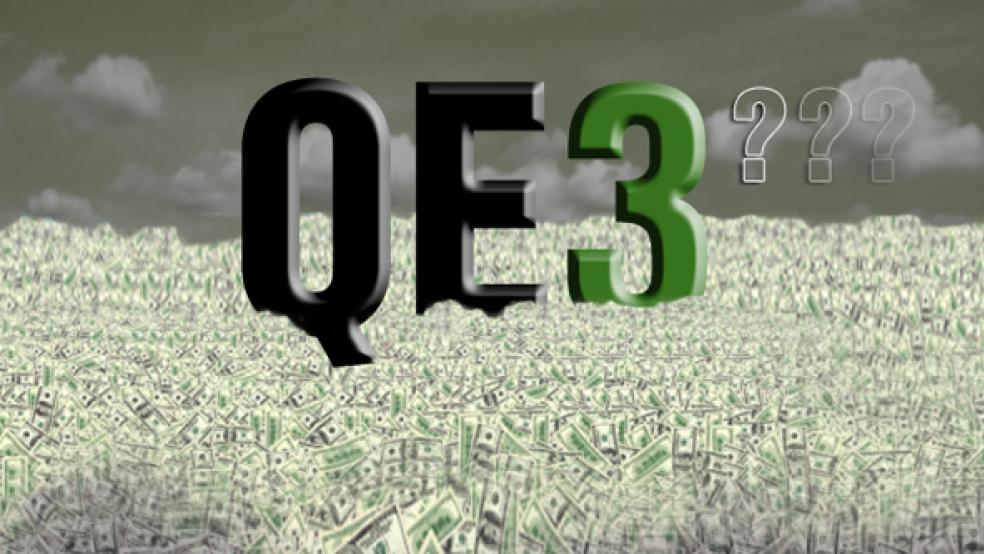Take this quiz--True or False: QE3 is:
a) a luxury ocean liner
b) the third in line for the British crown
c) an infusion of capital from the Federal Reserve to stimulate the economy
This is, after all, The Fiscal Times, so the answer is “c.” If the Federal Reserve moves forward with a the third round of an unconventional government monetary policy called quantitative easing, which is used by central banks to stimulate the economy, it will be known as QE3. It’s a grand attempt to fortify, rescue, and otherwise beef up the national economy after the financial crisis sucked the marrow out of it. It’s a cash infusion by the Federal Reserve, which buys its own Treasury bonds from banks.
In short, it’s a stimulative tool, a liquidity bath. It’s money, money, money, money.
John M. Berry, a columnist for The Fiscal Times who has covered the independent body known as the Federal Reserve for more than 25 years, describes the policy this way: “Quantitative easing is a process of adding cash directly to the banking system, which was first used several years ago by the Bank of Japan. It’s an alternative to the usual process of injecting cash to bring down interest rates when those rates are already at or close to zero.”
Berry explains further: “The Federal Reserve's technique is different. It has purchased mortgage-backed securities and Treasuries on the open market with cash that then gets deposited in banks. The Fed has encouraged this process by paying a low interest rate on these bank reserves, which until a couple of years ago it could not legally do. The point of the exercise has been to reduce longer-term interest rates, such as those on home mortgages, and stimulate the economy. Because of the intermediate step of buying securities rather than force-feeding cash to the banks, the Fed has declined to call its process quantitative easing – though just about everyone else does.”
QE1, as it’s known, or the first round of quantitative easing, took place during the beginning of the 2008 financial crisis and lasted until March 2010. In that period, the Fed bought $1.7 trillion of Treasury bonds and mortgage-backed securities and cut short-term interest rates, which helped stimulate bank lending to businesses and consumers. The Fed then shifted its focus to lowering long-term interest rates. During the second quantitative easing, or QE2, it bought only Treasury bonds. It did this “in part,” said Sudeep Reddy in The Wall Street Journal, “because some officials had misgivings about targeting a particular sector of the economy by purchasing mortgage-backed securities, and in part because the first round of purchases successfully shrunk an unusually wide gap between the rates on U.S. Treasurys and rates on mortgages.”
QE2 officially ended on June 30, 2011, when the Fed wound down its series of bond purchases.
Now, with a stagnant economy, high joblessness, a serious housing decline and pressures from the European debt crisis, there’s talk of a new round of quantitative easing, or QE3, which some say may be necessary for the Fed to consider, given that we may well be on the verge of a double-dip recession – or enmeshed in it already.
“Though it’s probably too soon to do this, the Fed is going to want to put quantitative easing on the table as an option,” says Julia Coronado, chief economist for North America at BNP Paribas in Manhattan. “We’ve seen the financial markets feel a lot of stress this week. Many forces are at work behind that, including the European situation and uncertainty there, as well as a loss of momentum in the U.S. economy. It just seems that every time the Fed tries to end its QE policies, the recovery is too fragile and the economy is not self sustaining.”
Coronado adds, “Inflation has been high, and one of [the Fed’s] mandates is to keep prices stable. So ultimately their credibility gets tested there. If they ignore their mandate to keep prices stable, they run the risk of leading inflation expectations to rise.”
And here’s the rub: Had there been no earlier rounds of quantitative easing, “We just don’t know what would have happened to the U.S. economy,” says Coronado.
Naturally, though, rounds of quantitative easing, one after the other, aren’t without risk or controversy. “The Fed may attempt QE3,” says Pavlina Tcherneva, professor of economics at Franklin and Marshall College in Pennsylvania. “But as we learned from QE1 and QE2, it will do nothing for growth.”
Blaire Briody of The Fiscal Times contributed reporting to this article.





